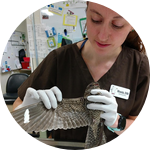About This Project
Significant declines in North American songbird populations over the past 50 years highlight the need for research on new and varied threats to these species. Current known contributing factors include habitat loss, pesticide use, and climate change, however little is known about the effects of heavy metal toxicity. This project aims to screen blood lead levels in songbirds admitted to a wildlife hospital to determine the risk of lead exposure and correlate with cause of admission and outcomes.
Ask the Scientists
Join The DiscussionWhat is the context of this research?
Lead pollution is a widespread, global issue affecting both humans and wildlife. Environmental contamination, especially in urban settings, is persistent despite bans on the use of lead in paint, gasoline, and other products. Lead toxicity in raptors and waterfowl due to ingestion of fishing sinkers or lead shot is well known and has been extensively studied over the last 50 years. The risk of lead toxicity in songbird species is less understood. The little research that exists suggests that songbirds may be at risk for lead exposure through ingestion of contaminated soils. There is evidence that even subclinical levels of lead exposure can lead to changes in songbird behavior.
What is the significance of this project?
Since 2018, we have performed blood lead testing on a small subset of songbird patients, mostly due to neurological symptoms. Of songbird patients tested, 11% had lead levels high enough for chelation treatment and 45% had detectable levels of lead in their blood (unpublished data). This research project will allow for broad screening of our songbird patients in order to determine the prevalence of lead toxicity in these species and better understand the potential impacts on a population level.
What are the goals of the project?
The main goal of this research project is to perform a concentrated testing effort to better assess the prevalence of lead exposure in songbirds admitted for rehabilitation. This information will improve rehabilitation efforts by determining the importance of screening for lead toxicity in this population. Due to their small size, it is more difficult to obtain a blood sample from songbirds and only a small blood sample can be safely taken. Therefore, a better understanding of the likelihood of lead exposure will help direct diagnostic testing for both patient welfare and resource management. This information will also expand our knowledge of population level impacts of lead exposure on songbird species.
Budget
Currently at the Wildlife Rehabilitation Center of Minnesota, we have a Magellan Diagnostics LeadCare II Analyzer that we use to perform in house blood lead testing on patients with signs consistent with lead toxicity. We routinely screen species that are known for having a significant prevalence of lead toxicity, such as waterfowl and swans, however we are currently unable to screen our songbirds due to budget constraints. Funding from this research project will allow for a concentrated testing effort over the next 12 months in order to better determine the prevalence of lead exposure in songbird populations. We will be concentrating testing efforts on songbirds with ground feeding strategies such as Blue Jays, Northern Cardinals, American Robins, thrashers, thrushes, and sparrows (among others), as these are the most likely to consume lead-contaminated soils.
Endorsed by
 Project Timeline
Project Timeline
Adult songbird patients will have a small blood sample taken under anesthesia during routine diagnostic testing or immediately prior to euthanasia for patients with injuries/illnesses too severe for rehabilitation. Location, admission cause, diagnosis, and outcomes will be recorded. Testing will be completed over one year to account for seasonal differences in blood lead levels and migration patterns, with analysis and manuscript preparation complete by Dec 2021.
Aug 31, 2020
Project Launched
Sep 01, 2020
Project launch and funding
Sep 01, 2021
Completion of testing
Oct 01, 2021
Data analysis
Dec 01, 2021
Manuscript completion
Meet the Team
Miranda Torkelson
Miranda Torkelson DVM, CWR is a wildlife veterinarian passionate about improving quality of care for wildlife in rehabilitation through adaptation of procedures in use in small animal veterinary medicine, examination of prognostic indicators, and research into improving treatment efficacy. She received her doctorate from the University of Wisconsin School of Veterinary Medicine and trained in small animal internal medicine, emergency medicine, and surgery through an internship at the Cummings School of Veterinary Medicine at Tufts University. Miranda was the 2019-2020 Partners for Wildlife Veterinary Intern through The Raptor Center and the Wildlife Rehabilitation Center of Minnesota (WRC). She is channeling her drive to improve the care of wildlife in rehabilitation by establishing a research program at WRC.
Additional Information
Founded in 1979, the Wildlife Rehabilitation Center of Minnesota is one of the leading wildlife hospitals in the country, admitting approximately 15,000 patients of about 188 different species each year.
Project Backers
- 55Backers
- 106%Funded
- $4,780Total Donations
- $83.27Average Donation

